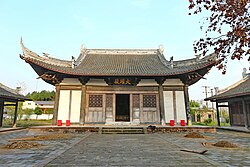Anzhou
| Ānzhōu Qū 安 州 区 Anzhou |
||
|---|---|---|
|
|
||
| Coordinates | 31 ° 32 ' N , 104 ° 34' E | |
 Location of Anzhou (red-brown in the southwest) within Mianyang Location of Anzhou (red-brown in the southwest) within Mianyang
|
||
| Basic data | ||
| Country | People's Republic of China | |
| Sichuan | ||
| District-free city | Mianyang | |
| ISO 3166-2 | CN-SC | |
| surface | 1189 km² | |
| Residents | 443,000 (2017) | |
| density | 372.6 Ew. / km² | |
| Website | anzhou.my.gov.cn | |
|
Kaixi Temple in Anzhou
|
||
Anzhou ( Chinese 安 州 区 , Pinyin Ānzhōu ) is a municipality in the prefecture-level city of Mianyang in the Chinese province of Sichuan . It administers a territory of 1189 square kilometers and at the end of 2017 had a total population of 443,000 people.
geography
Anzhou is located a little northeast of the actual urban area of Mianyang. It is bordered by Jiangyou to the east, Fucheng to the southeast, Luojiang ( Deyang County Free City ) to the south, Mianzhu to the southwest , Beichuan to the north, and Ngawa to the northwest . Its urban area occupies about 15 square kilometers. In the north-west of Anzhou are the Longmen Shan mountains with altitudes of 1000 to 2500 meters above sea level. The highest point is in the community of Gaochuan with an altitude of 3,047 meters. Qianfo Shan Mountain has a height of 2942.2 meters, here is a nature reserve on the national level. The lowest point of Anzhou is in Jiepai municipality at 490 meters above sea level. Almost 40% of Anzhou's territory consists of hill country. The most important rivers are the Anchang He , the Jushui He , the Xiushui He , Baixi He and the Chaping He .
Almost 40% of the Anzhou territory is forested. There are occurrences of rare animals - including the giant panda and rare plant species, including Chinese medicinal plants .
The climate of Anzhou is temperate with an annual average temperature of 16.3 ° C and four clearly distinguishable seasons. Anzhou receives an annual mean rainfall of 1261 millimeters and 1059 hours of sunshine. There are around 300 frost-free days a year.
population
The 2000 population census showed a total population of 484,224 people in 159,495 households, of which 248,774 men and 235,450 women. The same population census found that there were 99,221 people under the age of 14, 347,421 people between the ages of 15 and 64 and 37,582 people over 65 years of age.
The 2010 population census showed a total population of 366,802 people.
In 2017, 92,700 people were included in the urban population.
Administrative structure
Anzhou has existed intermittently since 1374, when An (安县) district was formed from An (安 州) district. On February 6, 2009, it was approved that Anchang , Yong'an Towns and part of Huangtu Township could be spun off from An and subordinated to the Qiang Autonomous County of Beichuan . As a result, An shrank by 215 square kilometers and its population decreased by 78,000 people. On March 20, 2016, the State Council approved the formation of an urban district from An. This was implemented on May 20th of the same year.
As of 2018, Anzhou consists of 15 large municipalities and three municipalities . These are:
- Large communities Sangzao (桑枣镇) Huagai (花荄镇) Huangtu (黄土镇) Tashui (塔水镇) Xiushui (秀水镇), Heqing (河清镇) Jiepai (界牌镇), Yonghe (永河镇), Jushui (雎 水镇), Qingquan (清泉 镇), Baolin (宝 林镇), Feishui (沸水 镇), Xiaoba (晓 坝镇), Lexing (乐 兴镇), Qianfo (千佛 镇)
- Communities Xingren (兴仁乡) Gaochuan (高川乡) Yingxin (迎新乡)
At the village level, the above-mentioned administrative units are made up of 27 communities and 230 villages . The seat of government in An County had been in Anchang Township since 1374 and was relocated to Huagai Township in 2002.
Economy and Transport
Anzhou's gross domestic product was 13.2 billion yuan in 2017, up 9.2% from the previous year. The gross domestic product was generated to 22.5% in the primary sector , 38.2% in the secondary sector and 39.3% in the tertiary sector. The average income of the urban population was 30,005 yuan and that of the rural population was 15,430 yuan.
The Mianyang – Guangyuan Highway , National Roads 108 and 105 run through Anzhou territory.
Culture
Attractions for visitors include Anzhou Nature Reserve, Qianfo Shan National Park, Baishui Hu Lake , Luofu Shan Landscape , Longquan Ligong Cave, and Qianfoshan Battle Site.
Individual evidence
- ↑ a b c d e f 绵阳 市 安 州 区 情 简介.中共 绵阳 市 安 州 区委 绵阳 市 安 州 区 人民政府, July 3, 2018, accessed on August 11, 2019 (Chinese).
- ↑ a b c 自然地理.中共 绵阳 市 安 州 区委 绵阳 市 安 州 区 人民政府, August 30, 2017, accessed on August 11, 2019 (Chinese).
- ↑ 四川省 乡 、 镇 、 街道 人口. (No longer available online.) State Statistical Office of the People's Republic of China , archived from the original on June 17, 2019 ; accessed on June 11, 2019 (Chinese).
- ↑ a b 安县 历史 沿革.行政 区划 网站, May 13, 2015, accessed on August 11, 2019 (Chinese).
- ↑ a b 安 州 区. State Statistics Office of the People's Republic of China , accessed August 11, 2019 (Chinese).
- ↑ a b 安县 概况 地图.行政 区划 网站, May 13, 2015, accessed on August 11, 2019 (Chinese).

